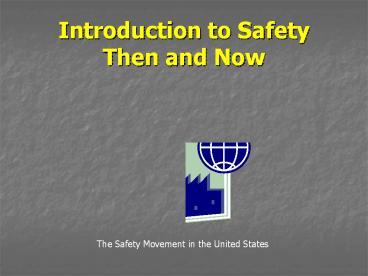Introduction to Safety Then and Now - PowerPoint PPT Presentation
1 / 17
Title:
Introduction to Safety Then and Now
Description:
Introduction to Safety Then and Now The Safety Movement in the United States Reason for this course Occupational Safety and Health in the workplace has undergone ... – PowerPoint PPT presentation
Number of Views:93
Avg rating:3.0/5.0
Title: Introduction to Safety Then and Now
1
Introduction to SafetyThen and Now
The Safety Movement in the United States
2
Reason for this course
Occupational Safety and Health in the workplace
has undergone drastic changes in the past twenty
years. The reasons for this are numerous. Some
of the more important reasons include
technological changes that created new hazards,
creation of new safety and health legislation,
increased pressure from certain regulatory
agencies, executives realizing that safe and
healthy environments encourage increased
productivity, an increase in the cost of health
care and workers compensation, pressure from
environmental groups, pressure from the public,
pressure from labor organizations,
professionalization of the health and safety
occupations, cost of product safety litigation
and, increased workplace violence. When put
together, all of these factors make the job of
the skilled trades professional more challenging
and more important than ever before and a need
for an updated Safety training program that
includes the most recent information available.
3
Accidents were Common Place in the Early 1900s
- 19073200 people killed
- Today4 per 100K (NSC)
- Reasons for Change
- Cost, Pressure for Legislation and,
Professionalization of Safety as an Occupation
Safety is not a new concept
4
Evidence of Safety in ancient civilization.
- Hammurabi 2000 B.C.
- His code contained clauses for dealing with
injuries, doctors fees and, monetary awards from
those who injure others. - Rameses II 1500 B.C.
- Created an ancient EMS to care for slaves and
developed requirements of hygiene. - Roman Empire 1567
- Provided medical care for workers.
5
Historical Knowledge of Diseases
- 1567-Philippus Aureolus Treatise on the
pulmonary diseases of miners. This work also
identified health risks of handling Mercury. - 1700-Bernardino Ramizzini Treatise on workers
diseases Correlation between occupations and
injuries. - 1964-Dr. Irving J. Selikoff Reported on the
effects of asbestos at a conference. - 1900- Fredrick Taylor A factors influencing
efficiency in manufacturing.
6
The Industrial Revolution
- Steam Power
- Machines
- New Ways of Raw Material Conversion
- A Division of Labor
These factors created a need to focus on the
safety and health of workers. The introduction
of steam power created the potential for life
threatening injuries as did all machines. The
new methods introduced for converting raw
materials also created risks and new ways to get
hurt or sick. Specialization of labor increased
boredom and, therefore, the possibility of
inattentiveness which promotes a more dangerous
work environment.
7
Significant Achievements in the Safety
Movement(A time line of events)
- Health and Morals of Apprentices Act
1802-England - Factory Inspection 1867-Massachusetts
- First Barrier 1868
- Pennsylvania 1869 Mine Safety Law
- Bureau of Labor Statistics (BLS) 1869
- Massachusetts 1877 Requirement of Guards on
Hazardous Equipment
8
Significant Achievements in the Safety
Movement(A time line of events)
- Employers Liability Law 1877
- First Safety Program 1892 Illinois
- Fredrick Taylor Study 1900 Safety and Management
connection with Lost Time - Bureau of Mines 1907 Investigate
Accidents-Examine Health Hazards
9
Significant Achievements in the Safety
Movement(A time line of events)
- Workers Compensation Idea 1908 (Federal
Employees) - First Effective Workers Compensation, Wisconsin
1911 - First Cooperative Safety Congress meets in
Milwaukee 1912 - National Council of Industrial Safety formed
1913 - National Safety Council is formed 1915
10
Significant Achievements in the Safety
Movement(A time line of events)
- Concept of Negligent Manufacture 1916
- U.S. Secretary of Labor convenes the 1st National
Silicosis Conference 1936 - Occupational Safety and Health Act Passed 1970
- Federal Mine Safety Act Passed 1977
- Superfund Amendments and Reauthorization Act
Passed 1986 - Amended Clean Air Act of 1970 Passed 1990
- Total Safety Management Concept 1996
- ISO 14000 sought by U.S. firms for environmental
safety management 2000 - Workplace Terrorism becomes a growing concern of
SH professionals 2003
11
Tragedies that Caused Change
- Hawks Nest Incident (1930s,)
- Now why dont he write home?
- Asbestos/Asbestosis (1964)
- Dr. Irving J. Selikoff reports on the effects of
asbestos on workers exposed to it. - Bhopal/Union Carbide (1984)
12
The Role of Organized Labor
- Safer Working Conditions
- Worker Compensation
- Overturn Anti-labor Laws/Fellow Servant Rule
13
Specific Health Problems
- Lung Diseases and Law Enactment
- Gauley Bridge Disaster
- Mercury Poisoning
14
Development of Accident Prevention ProgramsThe 3
Es of Safety
15
Development of Safety Organizations
- National Safety Council (NSC)1915
- National Institute for Occupational Safety and
Health (NIOSH) and Centers for Disease Control
(CDC)
16
Safety and Health Today
- OSHA and the Integrated Approach
- Employers must provide appropriate medical
treatment for injuries and illness. - Employees that have been exposed to toxic
substances must be examined regularly. - Employers must have a qualified first-aid person
present during all working hours.
17
Lesson Review
- 1. List some of the early causes that have had
the greatest impact on Workplace Safety to date. - 2. What does the Code of Hammurabi have to do
with Safety History? - 3. What circumstances where responsible for the
first safety program? - 4. How is Fredrick Taylor connected to the safety
movement? - 5. Explain the development of the National Safety
Council. - 6. What impact did labor shortages in WWII have
on the safety movement? - 7. Explain how workplace tragedies have affected
the safety movement? List examples. - 8. Explain the primary reasons behind passage of
the OSHA act. - 9. What role did organized labor have on the
safety movement? - 10. Explain the three Es of safety.




















![[PDF] Introduction to Critical Care Nursing 8th Edition Free PowerPoint PPT Presentation](https://s3.amazonaws.com/images.powershow.com/10079332.th0.jpg?_=20240716074)










